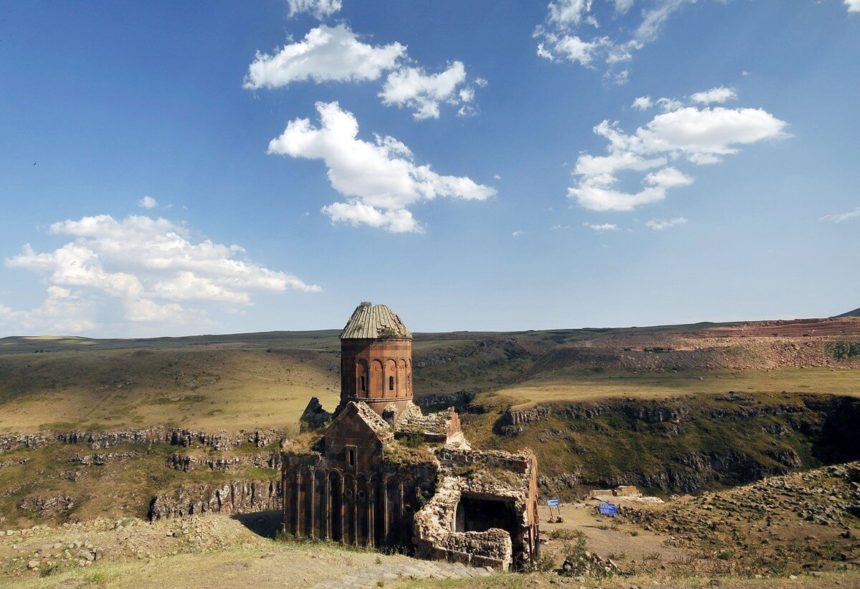Situated on the eastern border of Turkey, across the Akhurian River from Armenia, lies the empty, crumbling site of the once-great metropolis of Ani, known as “the city of a thousand and one churches.” This ancient Armenian capital today is a perfect blend of ancient ruins, beautiful landscapes, and complete lack of crowds… a rare combination for a historic site of such awe inspiring beauty.
Renowned as a cultural and commercial centre on the Silk Road, Ani grew to become a bustling metropolis of over 100,000 inhabitants at its height. Today, it’s an eerie, abandoned city of ghosts that stands alone on a plateau in the remote highlands of northeast Turkey.
The site had a turbulent history: changing hands multiple times, withstanding sieges, massacres, earthquakes, and looting – which led to its eventual abandonment. Despite this, the site has been seen as a place of extreme beauty, architectural marvel, and rich history for both the Turks and Armenians.

History of Ani
Ani was first mentioned in Armenian chronicles in the 5th century that described a fortress settlement of the nobles of the Kamsarakan dynasty. Ani’s most glorious period fell between 961 CE and 1045 CE when it served as the capital of the Bagratid Armenian kingdom. It was during this period that the city underwent a massive building and growth phase where countless churches and monuments were constructed.
The city expanded rapidly to become the chief political, cultural and economic centre. Its size and influence also added it to the Silk Road with routes along the original route making it an additional stop to sell and exchange goods.
By the start of the 11th century the population of Ani was well over 100,000 and it gained renown as the “city of forty gates” and the “city of a thousand and one churches.”
Decline of Ani
Ani’s glory days would abruptly come to an end in 1064 CE when the Seljuks would conquer the city, slaying or imprisoning much of the population as they went. For almost two hundred years thereafter the city would be controlled by various kingdoms, including the Georgians.
“The army entered the city, massacred its inhabitants, pillaged and burned it, leaving it in ruins and taking prisoner all those who remained alive…The dead bodies were so many that they blocked the streets; one could not go anywhere without stepping over them.”
-Arab historian Sibt ibn al-Jawzi, c. 1064
In 1236, the Mongols captured the city and massacred much of the population, then Tamerlane rampaged through and mercilessly destroyed what was left.
With no need for churches and other buildings, Ani was left to decay with an earthquake in 1319 leveling much of the city and its monuments. By the 14 th century, the city was under the control of local Turkish dynasties and soon became part of the Ottoman Empire. In 1735 the site was completely abandoned when the last monks left the monastery. What you see today is mostly the remnants of that earthquake as much has not changed for nearly 700 years.
Rediscovered and romanticized in the 19th century, the city had a brief moment of fame, only to be closed off by World War I and the later events of the Armenian Genocide that left the region an empty, militarized no-man’s land.
Remains
This medieval city combines residential, religious and military structures, characteristic of a medieval urbanism built up over the centuries by Christian and then Muslim dynasties.
Called the “city of a thousand and once churches”, archaeologists have found at least 40 churches, chapels, and mausoleums, all designed by the greatest architectural and artistic minds of their time.
The preserved remains of city walls, churches, public buildings, bridges and staging posts bear witness to great prosperity. The city was richly decorated with reliefs and ornamentation. On bridges, towers, churches and other buildings we find geometric patterns, plant ornamentation, crosses and animal figures. Some of the rich wall paintings in the churches are preserved; these show how different styles merged in Ani.
This medieval settlement consists of remains from a multi-cultural centre, with all the richness and diversity of Medieval Armenian, Byzantine, Seljuk and Georgian urbanism, architecture, and art development.
All the structures at Ani are constructed using the local volcanic basalt, a sort of tufa stone which is easily carved. The city’s many remaining churches are extraordinarily beautiful, even in their ruined state. The minaret Menüçehr Mosque, newer than many of the churches but still nearly a thousand years old, still stands as a testament to the city’s long history and diverse cultural influences. Other notable remaining buildings include the Cathedral, the church of St Gregory of Tigran Honents, and the citadel. The nominated area also includes the rock-cut dwellings and monuments outside the city walls.
Although Ani was forgotten and inaccessible due to political conflicts for hundreds of years, today we can walk among the ruins of magnificent buildings such as churches, monasteries and high city walls. Unique cooperation between Armenians, Turks and international partners has now enabled the study and preservation of Ani.
The ruins of Ani were included in the World Monument Fund’s Watch Lists of 100 Most Endangered Sites in 1996, 1998 and 2000. Restoration efforts began in 2011 by the World Monument Fund in partnership with the Turkish Ministry of Culture and in 2016, the city was listed as a UNESCO World Heritage Site.